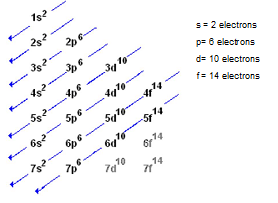
(a)
Interpretation:
The total number of electrons, valence electrons, group number, period and number of valence shell for oxygen should be determined.
Concept Introduction:
An atom is composed of three main sub-atomic particles; electrons, neutrons and protons. The
The distribution of electrons in an atom can be shown with the help of electronic configuration. The electronic configuration of an element represents the number of electrons in different energy levels of an element. The energy levels must be arranged in increasing order of their energy and can only accommodate a certain number of electrons as given:

(b)
Interpretation:
The total number of electrons, valence electrons, group number, period and number of valence shell for sodium should be determined.
Concept Introduction:
An atom is composed of three main sub-atomic particles; electrons, neutrons and protons. The atomic number of the elements represents the number of protons or electrons in a neutral atom. All known elements are arranged in a tabular form in increasing order of their atomic number that is called the periodic table.
The distribution of electrons in an atom can be shown with the help of electronic configuration. The electronic configuration of an element represents the number of electrons in different energy levels of an element. The energy levels must be arranged in increasing order of their energy and can only accommodate a certain number of electrons as given:

(c)
Interpretation:
The total number of electrons, valence electrons, group number, period and number of valence shell for phosphorus should be determined.
Concept Introduction:
An atom is composed of three main sub-atomic particles; electrons, neutrons and protons. The atomic number of the elements represents the number of protons or electrons in a neutral atom. All known elements are arranged in a tabular form in increasing order of their atomic number that is called the periodic table.
The distribution of electrons in an atom can be shown with the help of electronic configuration. The electronic configuration of an element represents the number of electrons in different energy levels of an element. The energy levels must be arranged in increasing order of their energy and can only accommodate a certain number of electrons as given:

Want to see the full answer?
Check out a sample textbook solution
Chapter 2 Solutions
EBK GENERAL, ORGANIC, & BIOLOGICAL CHEM
- How many elements exist with an atomic number less than 40 that are a. Halogens b. Noble gases c. Alkali metals d. Alkaline earth metalsarrow_forwardAn ion that has two more electrons outside the nucleus than there are protons in the nucleus will have a charge of_________.arrow_forward2.84 Early attempts to arrange the elements often focused on atomic weight. Mendeleev considered a number of properties in addition to atomic weight, so he realized that some elements seemed out of place when ordered by atomic weight. Using the modern periodic table, identify elements for which Mendeleev must have had to switch the order in order to get the correct sequence of elements.arrow_forward
- Group the following elements into three similar groups of two each: Na, O, Ne, Li, Ar, Sarrow_forward2-47 Which element in each pair is more metallic? (a) Silicon or aluminum (b) Arsenic or phosphorus (c) Gallium or germanium (d) Gallium or aluminumarrow_forwardDistinguish between the terms family and period in connection with the periodic table. For which of these terms is the term group also used?arrow_forward
- 2.42 What is a period in the periodic table? From what does it derive its name?arrow_forwardWhich of the following is true about an individual atom? Explain. a. An individual atom should be considered to be a solid. b. An individual atom should be considered to be a liquid. c. An individual atom should be considered to be a gas. d. The state of the atom depends on which element it is. e. An individual atom cannot be considered to be a solid, liquid, or gas. Justify your choice, and for choices you did not pick, explain what is wrong with them.arrow_forwardScientists are trying to synthesize elements with more than 114 protons. State the expected atomic number of (a) the newest inert gas. (b) the new element with properties similar to those of the alkaline earth metals. (c) the new element that will behave like the halogens. (d) the new (nontransition) metal whose ion will have a +2 charge. (e) the new element that will start period 8.arrow_forward
 Chemistry for Today: General, Organic, and Bioche...ChemistryISBN:9781305960060Author:Spencer L. Seager, Michael R. Slabaugh, Maren S. HansenPublisher:Cengage Learning
Chemistry for Today: General, Organic, and Bioche...ChemistryISBN:9781305960060Author:Spencer L. Seager, Michael R. Slabaugh, Maren S. HansenPublisher:Cengage Learning General, Organic, and Biological ChemistryChemistryISBN:9781285853918Author:H. Stephen StokerPublisher:Cengage Learning
General, Organic, and Biological ChemistryChemistryISBN:9781285853918Author:H. Stephen StokerPublisher:Cengage Learning Chemistry: The Molecular ScienceChemistryISBN:9781285199047Author:John W. Moore, Conrad L. StanitskiPublisher:Cengage Learning
Chemistry: The Molecular ScienceChemistryISBN:9781285199047Author:John W. Moore, Conrad L. StanitskiPublisher:Cengage Learning
 Introduction to General, Organic and BiochemistryChemistryISBN:9781285869759Author:Frederick A. Bettelheim, William H. Brown, Mary K. Campbell, Shawn O. Farrell, Omar TorresPublisher:Cengage Learning
Introduction to General, Organic and BiochemistryChemistryISBN:9781285869759Author:Frederick A. Bettelheim, William H. Brown, Mary K. Campbell, Shawn O. Farrell, Omar TorresPublisher:Cengage Learning World of Chemistry, 3rd editionChemistryISBN:9781133109655Author:Steven S. Zumdahl, Susan L. Zumdahl, Donald J. DeCostePublisher:Brooks / Cole / Cengage Learning
World of Chemistry, 3rd editionChemistryISBN:9781133109655Author:Steven S. Zumdahl, Susan L. Zumdahl, Donald J. DeCostePublisher:Brooks / Cole / Cengage Learning





